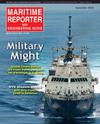
Page 43: of Maritime Reporter Magazine (September 2016)
Maritime & Ship Security
Read this page in Pdf, Flash or Html5 edition of September 2016 Maritime Reporter Magazine
DC ‘island’ controlled and optimized in- fully integrated,”said Lindtjorn. “Ferries board. An integrated power and energy for example. In addition, response time dependently, allowing Onboard DC Grid in Norway are seen as an extension of management system (PEMS) lets each can be improved when maneuvering, to combine smart DC distribution with the road network, and so the ‘zero emis- of the power sources play to its own while there is the potential to improve the advantage of AC components. sions ferry’ is an attractive concept that strengths, thereby coaxing the most out propulsion ef? ciency overall when a bat-
When a marine engine is operated at encourages the development of battery of the system overall,” said Lindtjorn. tery pack in installed.” constant speed fuel consumption is typi- technology.” Battery power also means Onboard DC Grid is also integral to the One of the obstacles to the uptake of cally minimized at around 85% load. In Seasight can run silently at up to 10 power, propulsion and automation for environmentally-friendly shore-power general, diesel electric solutions have al- knots in scenic UNESCO-listed fjords. world’s most advanced port icebreaker, as an option for ships in port, according ways involved variable propulsion drive/ In other cases, too, Lindtjorn said On- built by Russia’ Vyborg shipyard for to Lindtjorn, has been that limited power propeller speeds. DC Grid, in addition, board DC Grid’s energy storage capabil- heavy harbor ice conditions. Its ability ratings alongside force vessels to run allows generators to be run optimally ity has quickly become an increasingly to allow diesel engines to optimize ef? - onboard engines to cover peak onboard anywhere on the engine’s power curve, signi? cant driver for its uptake. “It is ciency while running at variable speeds loads. “If you need to run a parallel sys- offering a further means of fuel con- much easier to integrate energy storage is a compelling advantage when manag- tem anyway, some vessels chose not to sumption optimization. using a DC system than it is for AC, and ing ice conditions. use shore power at all,” he said. “Stor-
The ? rst Onboard DC Grid installation customers are coming to see that what “These are vessels that can take par- ing energy in a battery can overcome on the PSV Dina Star in 2013 saw owner they get is more functionality for the ticular advantage of variable speed gen- this issue; the ship can draw the current
Myklebusthaug Offshore con? rming sig- same investment.” erators, which already make widespread steadily from shore and adapt to peak ni? cant fuel savings according to ABB, Another reference is Exemplary, an use of frequency convertors. To be able loads using the battery.” with savings in low load conditions re- offshore vessel under construction: the to deliver that within a lean, more space To illustrate his point, Lindtjorn cites ported of up to 27%. In addition, even Cefront Technology concept for a ship- ef? cient convertor con? guration really ABB’s own selection of DC Grid for its when undertaking dynamic positioning ship oil cargo transfer vessel (CTV). A counts,” said Lindtjorn. advanced cable-laying vessel, due de- in challenging weather conditions, the 90m LOA vessel is being built by COS- livery from Norway’s Kleven shipyard owner has con? rmed that it has achieved CO Nantong and COSCO GuangZhou. Change of Current in 2017. “DC Grid’s integrated power 14% fuel savings. Here, Onboard DC Grid will allow the “I see clear bene? ts for applying On- management plus energy storage is once ship’s four 3600kW ABB generators to board DC Grid in combination with a more expected to cut fuel consumption
DC Grid: Moving Forward operate at variable and optimum speeds, battery in the coastal tanker segment,” signi? cantly; but this ship will also ex-
While logically it might be assumed with a DC Grid-compatible 350kWh Lindtjorn said. “Owners have shown real ploit shore power to spool cables from a that the prolonged slump in energy pric- battery used for energy storage, back commitment to ships that are more envi- dockside production facility. It would be ing would place fuel ef? ciency technolo- up, enhanced dynamic support and peak ronmentally-friendly in this market. One possible to use a conventional AC solu- gy investment on the backburner, ABB’s shaving. entry point for DC Grid might be vari- tion for this, but the point is that this is experience has been counter to this log- “The approach simpli? es the process able speed shaft generators, and owners another example of how DC Grid’s lack ic, and it reports that Onboard DC Grid of exploiting stored energy as a source can then consider the advantages of us- of complexity makes dockside spooling orders have powered on. for power in a way that is functionally ing DC Grid as a more ef? cient way of not so much possible as integral to the
John Lindtjorn, ABB Product Manager integrated with the other sources on handling pumps, loading and unloading, ship’s capabilities.”
Onboard DC grid and Energy Storage, said this is because Onboard DC Grid offers owners far more than fuel savings and improved dynamic response. The sheer variety of vessel types specify- ing Onboard DC Grid have highlighted other telling bene? ts. Heading the list, he said, is the way DC Grid comes into its own in terms of energy storage, but there are others: STOCK (Purchase and Rental): s

 42
42

 44
44
